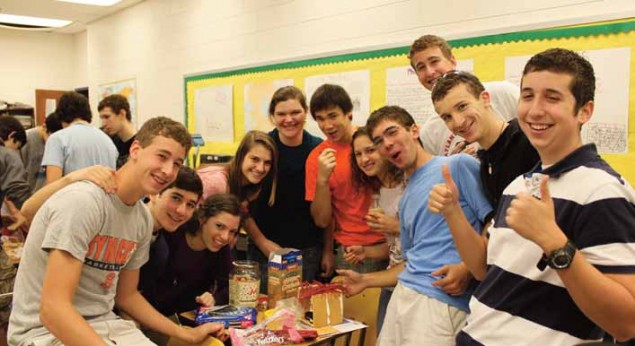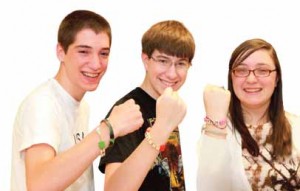Something strange is happening in Silicon Valley.
A growing number of Jews living at high-tech industry’s doorstep are dramatically changing their surfing habits. They’ve been clicking away from Google, Facebook and Twitter and onto Rashi, Rambam and Tosafot. The spiritual upgrade is not only changing their online habits, it’s changing their lives.
“There are hundreds of people involved in learning—in classes and chavrutot,” says Rabbi Joey Felsen, executive director of the Palo Alto kollel, also known as the Jewish Study Network (JSN), one of the catalysts of this Torah fervor. “The religious infrastructure here has really taken off,” Rabbi Felsen says.
Due to an influx of dynamic Torah educators, many residents of the San Francisco Bay area, long bereft of Jewish resources, are getting excited about their Judaism. Palo Alto, located thirty-five miles south of San Francisco, serves as “the center of all this Torah excitement,” according to Rabbi Yitzchok Feldman of Palo Alto’s Congregation Emek Beracha. The city currently boasts a cohesive community, a nearby day school, a thriving kollel, two kosher eateries and an eruv.
Amid the material and academic wealth of Silicon Valley, there’s a hunger for meaning. “The kids [in the Silicon Valley region] respond to something more intellectual, more philosophical than your average kid,” says Rabbi Effie Goldberg, executive director of West Coast NCSY. “It’s part of the culture here.”
Taking more classes is actually considered “cool’’ among Silicon Valley kids, according to Rabbi Avi Stewart, program director of JSN. “[The students] are open to it,” he says. “As it says in Pirkei Avot, it’s like writing on a fresh piece of paper. They just want to learn.”
Amid the material and academic wealth of Silicon Valley, there’s a hunger for meaning.
“The raw number of Jews in the San Francisco Bay area is staggering,” says Rabbi Steven Burg, OU managing director and international director of NCSY.
“You had huge numbers of Jewish students who knew zero [about Judaism], yet there was very little in the way of educational resources for teens,” recalls Rabbi Burg, who recently hired Rabbi Baruch Noy to start an NCSY chapter in Palo Alto. Rabbi Noy, who moved from Israel with his family, has been working round-the-clock to create cutting-edge social and recreational programs that appeal to teens and promotes Jewish identity.
Rabbi Steven Weil, executive vice president of the OU, sees the Palo Alto chapter as an opportunity to reach hundreds of thousands of students who have virtually no exposure to anything Jewish. “NCSY’s quality programming is giving many of these kids their first meaningful Jewish experience,” he says. “We’re looking at the future of Jewish America.”
![]() Kids are drawn toward NCSY’s cutting-edge social and recreational programs that promote Jewish identity.
Kids are drawn toward NCSY’s cutting-edge social and recreational programs that promote Jewish identity.
“In every school I walk into to try to recruit kids, I find students who are totally disconnected from Judaism,” says Rabbi Noy, who is currently launching “Latte and Learning” programs throughout the area. The program draws high school students to coffee houses with an offer of free coffee and stimulating conversations.
A COMMUNITY IS BORN
According to the 2004 Jewish Community Federation Survey (JCF), some 400,000 Jews live in the San Francisco Bay region, making it an area with the third-largest Jewish population in the US (falling in right behind New York and Los Angeles). This explosion in the Jewish population is most evident in the South Peninsula, which includes San Jose, Sunnyvale and Palo Alto, where the number of Jews has increased by 250 percent since the JCF survey in 1986, the last survey conducted prior to the one in 2004.
The Jewish roots of Palo Alto date back to the 1960s, when some Torah-observant pioneers, mostly Stanford University graduates, established a Shabbat morning service at the campus Hillel. Over time, the “Stanford Hillel Orthodox Minyan” grew into the “Palo Alto Orthodox Minyan,” which met in various temporary facilities. In 1995, the minyan hired Rabbi Feldman, its first full-time rav. In 1998, the minyan became “Congregation Emek Beracha.” Today, the shul enjoys a membership of 150 families, and a steady stream of newcomers.
 Congregation Emek Bracha, an OU-member shul in Palo Alto, enjoys a membership of 150 families, and a steady stream of newcomers. Courtesy of Congregation Emek Beracha
Congregation Emek Bracha, an OU-member shul in Palo Alto, enjoys a membership of 150 families, and a steady stream of newcomers. Courtesy of Congregation Emek Beracha
Tagging itself as “the Orthodox shul for everyone,” Congregation Emek Beracha, an OU-member shul, opens its doors to every type of Jew. “We have a happy mix of backgrounds,” says Rabbi Feldman, a native of Chicago, who received semichah from Mercaz HaTorah in Israel.
According to Rabbi Feldman, the Bay area “has a lot of Jews, always had,” but lacked the infrastructure for religious life. “San Francisco had a thriving Jewish community until shortly after World War II, but it never took off,” he says. “Chinuch wasn’t addressed as robustly here as it was in Los Angeles. Over the years, when the population wanted to open Orthodox schools in LA, [the community’s response] was ‘whatever floats your boat,’ while day schools in the San Francisco area faced open hostility. In the late ‘60s and early ‘70s, the Federation didn’t want to give the [schools] funding. Its members were part of the assimilationist ethic and they saw the day school as un-American. Ironically, the day school model has now been embraced by some of the same people who originally rejected it.”
 Rabbi Baruch Noy recently moved to the San Francisco Bay area to start an NCSY chapter in Palo Alto.
Rabbi Baruch Noy recently moved to the San Francisco Bay area to start an NCSY chapter in Palo Alto.
Currently, the Palo Alto area does boast a Jewish day school—the South Peninsula Hebrew Day School. Based in Sunnyvale, the school serves 243 students who come from Palo Alto and its surrounding communities.
Boris Feldman (no relation to the rabbi), fifty-four, a twenty-four-year resident of Palo Alto and a head partner in one of Silicon Valley’s top law firms, made the switch from a Conservative shul to Congregation Emek Beracha. His daughter, Talya, started walking to shul and taking Torah classes with her mother.
 NCSY reaches more than 35,000 teens in more than 200 cities throughout North America.
NCSY reaches more than 35,000 teens in more than 200 cities throughout North America.
The Feldman family’s entry into the Torah community began with a phone call from Rabbi Feldman requesting the lawyer’s help in attaining the rights to put up a community eruv. “They’d been trying for seven years and the city had denied it,” says Feldman [Boris]. “It took us four more years, but we got an eruv.” In the process, he befriended the Orthodox community and discovered a penchant for learning Torah.
“I’ve gone to [non-Orthodox] shuls my whole life, but [the rabbis] never really talked about the Talmud,” says Feldman, the son of Holocaust survivors. “How many Bar and Bat Mitzvah celebrations have you gone to where they actually talk about what’s in . . . this week’s parashah? . . . We have one of the world’s richest troves of thought, knowledge, and debate, going back centuries. I never had this until I was in my fifties, [yet, I feel] a freshness and a joy from learning that other Jews get when they are in their teens or twenties. I feel lucky I found it.”
Congregation Emek Beracha sometimes hosts community-wide events with the original kiruv couple in town, Rabbi Yosef and Dina Levin, of Chabad, who arrived in the early ‘80s. The Levins run the Chabad of Greater South Bay, and offer services including a teen club, Bar/Bat Mitzvah instruction, holiday awareness programs and many other community events.
RAISING THE LEVEL OF JEWISH LITERACY
Another powerful boost to the community arrived in 2001. Rabbi Felsen, a Toronto native and graduate of the Mir Yeshiva in Yerushalayim, was “looking to make some kind of impact.” “My wife and I wanted to start with targeting adult education,” says Rabbi Felsen. He spoke with Moishe Bane, chairman of the OU Board of Governors, who has a keen understanding of the outreach needs of various communities. Mr. Bane urged him to bring his kollel to the Bay area. “With the presence of Stanford University, among other universities, the population tends to be highly sophisticated,” says Bane. “My impression was that they were ripe for someone of [Joey’s] talents.”
 NCSY students made bracelets with their hebrew names proclaiming their Jewish pride.
NCSY students made bracelets with their hebrew names proclaiming their Jewish pride.
Rabbi Felsen promptly arranged to bring six families from Eretz Yisrael to form the Jewish Study Network with the aim of “raising the level of Jewish literacy.” Through its innovative programming, JSN provides entryways to Yiddishkeit that appeal to Jews at any stage.
“Operation Maccabim,” for example, has JSN rabbis go Chanukah-party hopping from home to home, delivering thought-provoking derashot. “We had eight hundred fifty people exposed to some meaningful Chanukah content that they would never have had otherwise,” says Rabbi Felsen. “It’s all about networking, that’s how the Silicon Valley works.”
If not for the significant changes taking place in the Bay area, Stanley Sussman’s retirement would probably have looked very different. Sussman, an original member of the Stanford Hillel Orthodox Minyan and a co-founder of the South Peninsula Hebrew Day School, arises each morning at 5:30 a.m. to learn the daf with the rosh kollel and then participates in various shiurim. “Between the shul, the kollel and Chabad, there’s a lot of learning [going on here],” he says. “It’s a beautiful place to live.”
Seeking to grow, the frum community in Palo Alto does face significant obstacles. Jews primarily flock to the area for Stanford University degrees, making for a highly transient population. Furthermore, Silicon Valley’s prohibitive real estate prices deter families from settling in Palo Alto. “I think it’s our biggest issue,” says Jacqueline Bocian, a Palo Alto resident for twenty-two years whose family left the Conservative synagogue to join Congregation Emek Beracha. “The homes here cost between one and four million dollars; that’s a real barrier to bringing more frum Jews here. [Otherwise], the area is idyllic. I think the Jewish community would expand by leaps and bounds if housing prices were normalized. There are not many communities—with different strands of Yiddishkeit and different levels—that work together the way we do.”
 The newly launched NCSY chapter in Palo Alto aims at changing the way hundreds of teens relate to their Jewish roots.
The newly launched NCSY chapter in Palo Alto aims at changing the way hundreds of teens relate to their Jewish roots.
Still, Rabbi Feldman sees Palo Alto as an emerging Torah community. Intent on securing the community’s spiritual gains for the next generation, JSN is gearing up to start a girls’ high school by the fall of 2011. Rabbi Feldman views this as the community’s most important development and hopes that a high school for boys will soon follow.
“People call me from the East Coast saying they have a job offer at Google, Yahoo, Hewlett Packard or any one of the high-tech companies and want to know if there’s kosher food available, a shul, a day school and an eruv,” says Rabbi Feldman. “Palo Alto can answer yes to all those questions.”
Chana Stoler is a writer living in Brooklyn, New York.